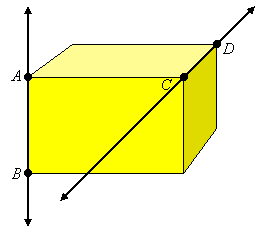It is important in the definition that we mention that the lines are in the same plane (they are coplanar). In space, two non-intersecting lines can be skew. Skew lines extend in different directions and do not intersect, as lines ![]() and
and ![]() in the following picture of a 3-dimensional box:
in the following picture of a 3-dimensional box:

The concept of a transversal is very important when studying parallel lines. Pairs of angles formed by the three lines are either congruent or supplementary, depending on which pair is named. Such pairs are given the following special names:
same-side interior
same-side exterior
alternate interior
alternate exterior
corresponding
The following pictures show what these terms mean:



When the two lines (other than the transversal) are parallel, it can be seen that same-side angles are supplementary (they add up to 180o), and when the angles are alternate or corresponding they are congruent (equal). The converses of these are also true. For example, if a transversal cuts two coplanar lines and the alternate interior angles are equal, then the lines must be parallel.